MARIANI’SVirtual Gourmet
January 15,
2012
NEWSLETTER
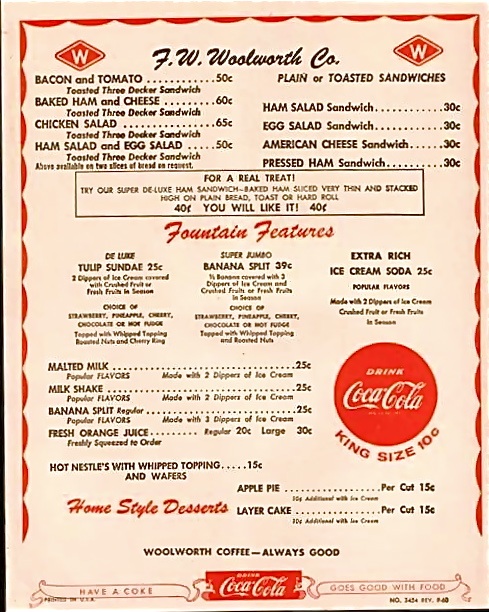
THIS WEEK
BRUSSELS
by John Mariani
NEW YORK
CORNER
New
York's Most New York Restaurants
by John
Mariani
❖❖❖
by John Mariani
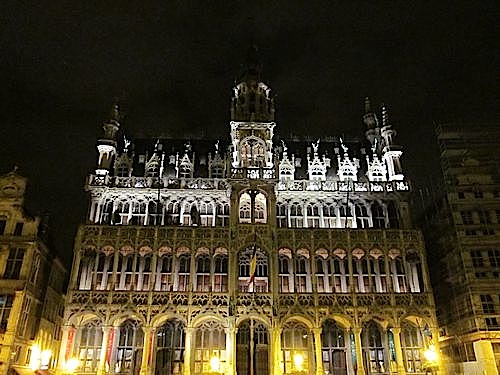
LA GRAND PLACE
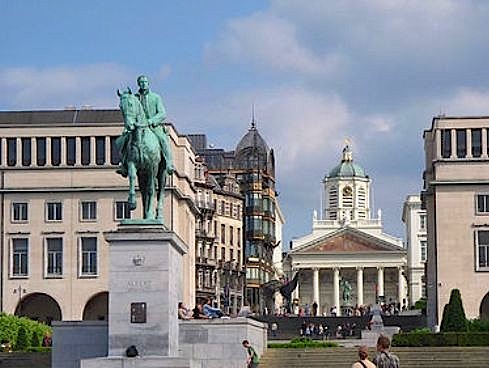 Brussels, whose name in
Old Dutch meant "home in the marsh," was founded as
something more than a village around 979, quickly
growing into a critical location for trade with
other northern European countries and becoming a
strong walled city by the end of the 14th century.
Flanders nobility intermarried with other European
bloodlines, and Charles V became the archduke of the
Hapsburg and Holy Roman Empires. For hundreds of
years afterwards Brussels would be fought over by
varying factions, including King Louis XIV of
France, who nearly bombarded the city out of
existence. In the 19th century, revolutionary
movements led to more liberal government control,
with Leopold I ascending the throne in 1831 and
adding measurably to the city's size and scope.
Independence followed, and in the 20th century,
through two world wars, Brussels emerged as a city
that became a stasis point in which concepts
of international cooperation could flourish within
vast bureaucracies.
Brussels, whose name in
Old Dutch meant "home in the marsh," was founded as
something more than a village around 979, quickly
growing into a critical location for trade with
other northern European countries and becoming a
strong walled city by the end of the 14th century.
Flanders nobility intermarried with other European
bloodlines, and Charles V became the archduke of the
Hapsburg and Holy Roman Empires. For hundreds of
years afterwards Brussels would be fought over by
varying factions, including King Louis XIV of
France, who nearly bombarded the city out of
existence. In the 19th century, revolutionary
movements led to more liberal government control,
with Leopold I ascending the throne in 1831 and
adding measurably to the city's size and scope.
Independence followed, and in the 20th century,
through two world wars, Brussels emerged as a city
that became a stasis point in which concepts
of international cooperation could flourish within
vast bureaucracies.You get a certain sense of that in Brussels' post-war architecture, which is stolid, gray, and imposing, but in the historic architecture built up over centuries you see the diversity of a true Dutch culture, medieval in its origins but always open to change, especially after successive wars took their tolls on the city center and its beautiful Grand Place, since 1988 a UNESCO World Heritage Site. Here you'll see the great Gothic town hall, where the many guilds of craftsmen met and, by virtue of their shared interests and wealth, ruled the city's destiny with economy foremost in their minds. Nevertheless, great art was part and parcel of their self image, and so over time Brussels has become home to more than 80 museums, not least the Museum of Modern Art, which is part of the
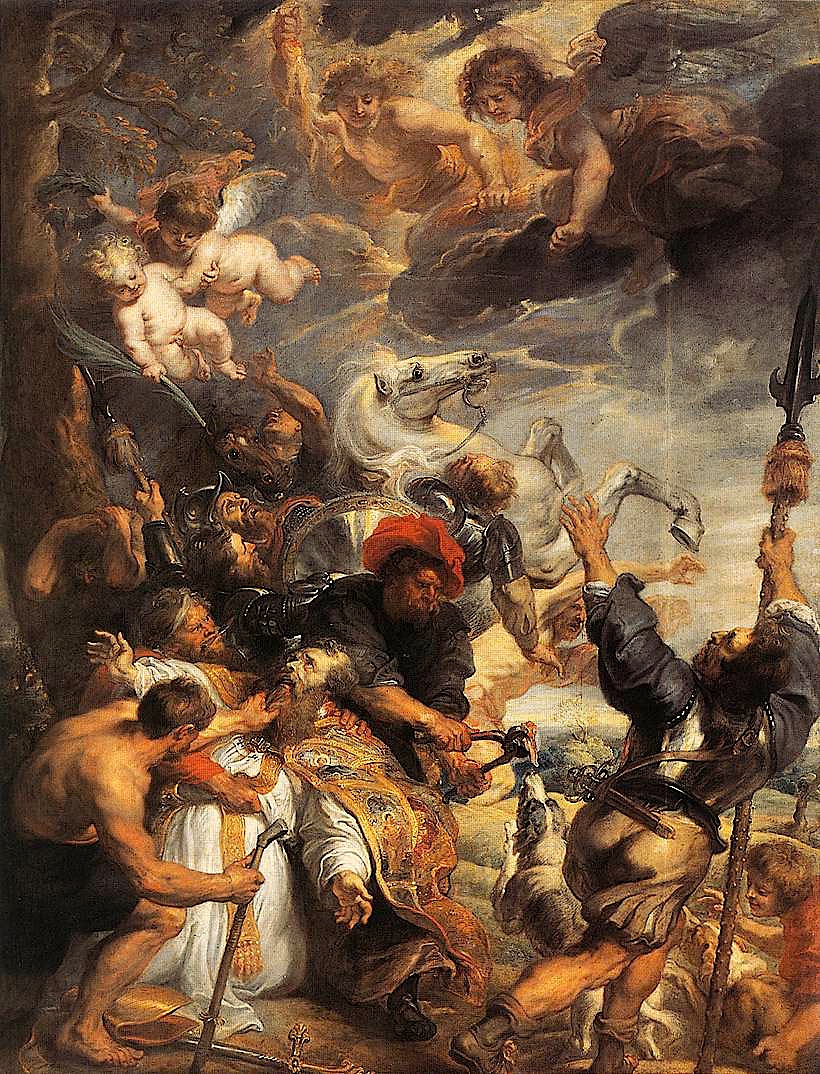 Royal
Museums of Fine Arts of Belgium (above)
Royal
Museums of Fine Arts of Belgium (above)The former's "modern" art begins in the 19th century, with an impressive collection of Belgian and other artists ranging from Jacques-Louis David and Ingres to Courbet and the Impressionists, then onward to Fauvism, Symbolism, and the avant-garde in Belgium. The oddly named Museum of Ancient Art is impossibly rich in van Dycks, Jordaens, Breughel, van der Weyden, Campin, Rubens (right, "The Martyrdom of St. Livinius") and other masters, from the 15th to 19th century.
 Everyone
makes a pilgrimage to the city's beloved Mannekin
Pis (left),
the bronze sculpture of a boy pissing into a
fountain, about which you may read extensively in
any guide book. Crafted in 1619 by sculptor
Hieronimus Duquesnoy, the figure's symbolic meaning
has never been determined, although legend has a
little boy heroically pissing on the heads of
invading foreign troops. The thing has been stolen
on several occasions, and now it must suffer the
indignities of being dressed up in different outfits
throughout the year, like a Ken doll, to the sound
of a brass band. Good for tourism, I suppose, like
the statue of Rocky atop the steps of the
Philadelphia Museum of Fine Arts.
Everyone
makes a pilgrimage to the city's beloved Mannekin
Pis (left),
the bronze sculpture of a boy pissing into a
fountain, about which you may read extensively in
any guide book. Crafted in 1619 by sculptor
Hieronimus Duquesnoy, the figure's symbolic meaning
has never been determined, although legend has a
little boy heroically pissing on the heads of
invading foreign troops. The thing has been stolen
on several occasions, and now it must suffer the
indignities of being dressed up in different outfits
throughout the year, like a Ken doll, to the sound
of a brass band. Good for tourism, I suppose, like
the statue of Rocky atop the steps of the
Philadelphia Museum of Fine Arts. Higher cultural attractions in the city flourish in institutions like the Brussels Theatre, the La Monnaie Theatre and opera house.
THE FOOD SCENE
Probably the first thing that comes to mind when people think of Brussels are its eponymous sprouts, a small cabbage developed in the city as of the 14th century. Next would come Belgian waffles, which are of a far more recent invention. Next would be the Belgian way of eating French fried potatoes (which, by the way, the French did not invent: in the 19th century the English word "french" meant to cut up a vegetable into thin slices). In Belgium they are served throughout the day with myriad toppings, from mayonnaise to vinegar and salt. Moules (mussels) are rampant. Chocolate stores, including many of the world's most famous, like Neuhaus and Godiva are native to the city and displayed in exquisite storefronts.
Brussels beers are also a proud product of the city, and no beer aficionado visiting Belgium can afford to miss the city’s museum of the Geuze, run by the Van Roy-Cantillon family since 1900, where the living microorganisms in the air cause the spontaneous fermentation of the traditional so-called Geuze lambic process, which begins with raw wheat, malted barley, and dried, three-year-old hops. The beer is pumped into chestnut barrels, where the fermentation begins, during which carbon dioxide seeps out through the wood; thus, the beer is not oversaturated with
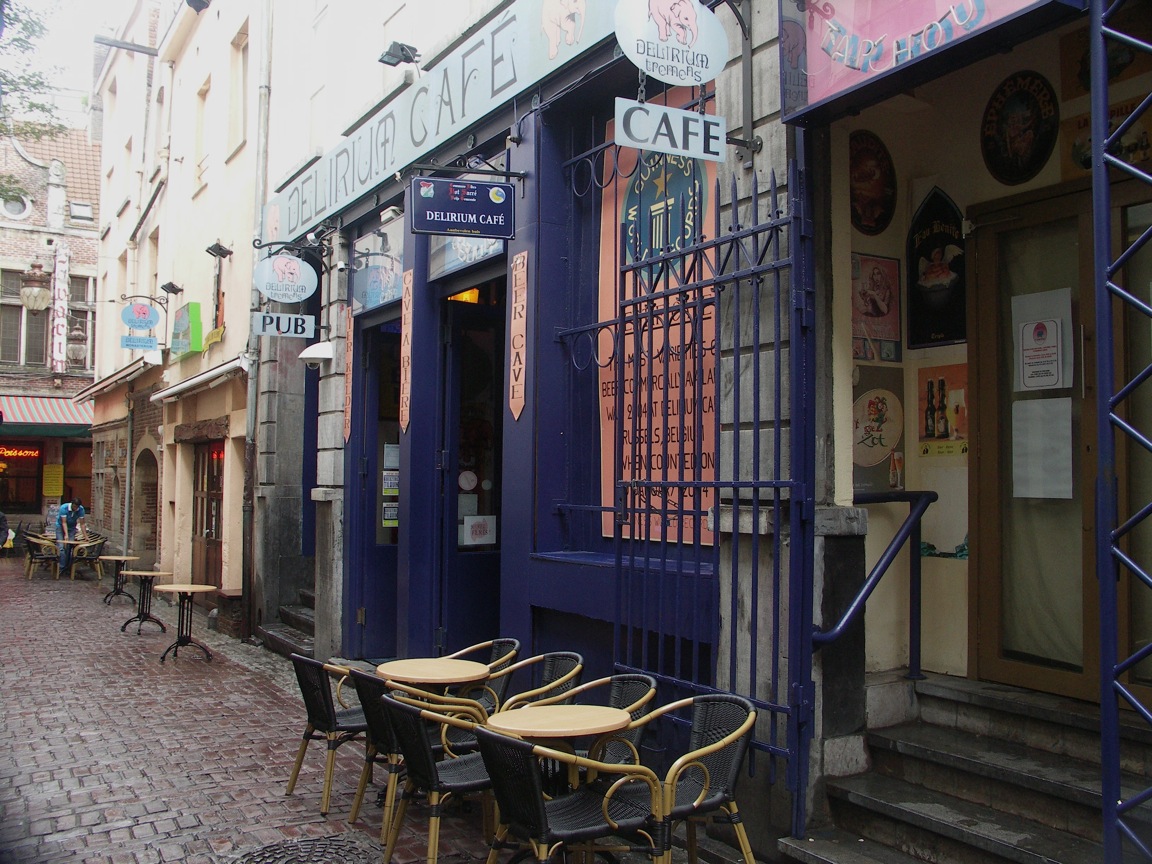 the
gas. The company claims its Greuze can age and
improve for more than 20 years.
the
gas. The company claims its Greuze can age and
improve for more than 20 years.
Brussels teems with pubs and beer brasseries, including one called Delirium Café (right)—on the appropriately named Impasse de la Fidelité--that lists more than 2,000 beers from all over the globe, every one described in text, including the Belgian Pink Killer, made from grapefruit.
As everywhere in Europe now, there is not a cuisine you cannot find among Brussels' 3,000 restaurant options, along with scores of bars and coffee houses, and brasseries serving those local beers. The most recognizable Belgian dishes would include waterzooi, a rich stew usually made with chicken or seafood, cream and eggs; Boterhammen, slabs of bread spread with a variety of toppings and eaten with a knife and fork; and the hearty beef stew called carbonnade.
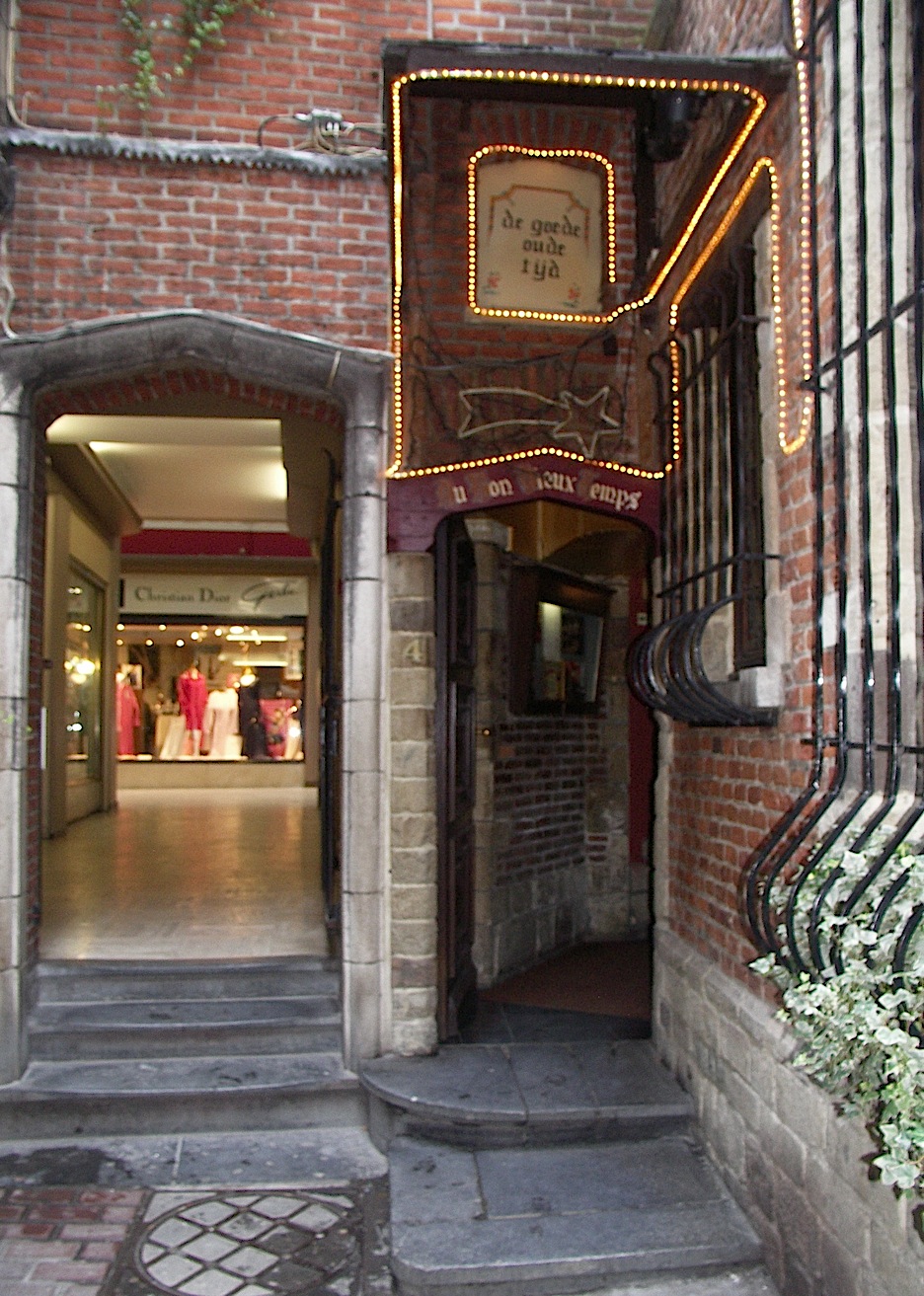 Such dishes
are the kind found in many of the narrow streets
around the cramped, bustling Rue des Bouchers, which
is touristy but not untypical in its menus. A
quick peek down an alley called Impasse St.
Nicholas, is requisite for barflies to visit,
for it is said to be the city's oldest eatery or
tavern, Au Bon Vieux Temps (left), whose
look and looming façade does put you in mind
of what such places were like back in the 16th
century. A better choice for restaurants is
the Rue des Dominicains near the Cathedral, also
frequented by tourists but more popular with the
locals. Here you'll find Bifanas (Portuguese);
Steak Frit' (beef); Scheltema (Belgian); and the
classic old Restaurant
Vincent (below)
founded in 1905 at Number 8, which would be hard for
anyone with a good appetite not to love, if just for
its old tiled walls alone, picturing game and
seafood, mariners and cooks, its beautiful ceiling,
and its Movado clock in the shape of a
Such dishes
are the kind found in many of the narrow streets
around the cramped, bustling Rue des Bouchers, which
is touristy but not untypical in its menus. A
quick peek down an alley called Impasse St.
Nicholas, is requisite for barflies to visit,
for it is said to be the city's oldest eatery or
tavern, Au Bon Vieux Temps (left), whose
look and looming façade does put you in mind
of what such places were like back in the 16th
century. A better choice for restaurants is
the Rue des Dominicains near the Cathedral, also
frequented by tourists but more popular with the
locals. Here you'll find Bifanas (Portuguese);
Steak Frit' (beef); Scheltema (Belgian); and the
classic old Restaurant
Vincent (below)
founded in 1905 at Number 8, which would be hard for
anyone with a good appetite not to love, if just for
its old tiled walls alone, picturing game and
seafood, mariners and cooks, its beautiful ceiling,
and its Movado clock in the shape of a 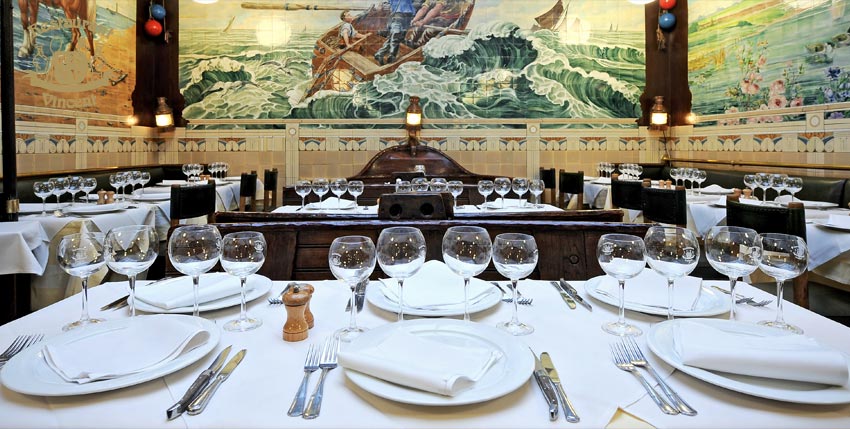 life
preserver. It is well lighted, there is bustle, all
the guests seem quite like old-timers, as do the
waiters in white shirts and black aprons; and the
menu hasn't changed very much in decades, aiming
more for perfection and consistency than
novelty. The wine list of about 50 bottlings
is exactly what it should be, geared to the food and
the clientele. Prices are moderate. (As everywhere
in Belgium, service and tax are included in the
price of your meal, so tipping is not necessary.)
life
preserver. It is well lighted, there is bustle, all
the guests seem quite like old-timers, as do the
waiters in white shirts and black aprons; and the
menu hasn't changed very much in decades, aiming
more for perfection and consistency than
novelty. The wine list of about 50 bottlings
is exactly what it should be, geared to the food and
the clientele. Prices are moderate. (As everywhere
in Belgium, service and tax are included in the
price of your meal, so tipping is not necessary.)You might begin with some Landes goose liver, or cold lobster with mayonnaise. There are always oysters of many varieties, and the shrimp croquettes are seriously addictive. There are six mussels dishes, from classic white wine to Provençale, all with a side of French fries. For seafood, whatever was freshest in the market that day will be your choice, perhaps cod or sole meunière--and Belgian butter is superb--or a special like eels in green sauce.
The meat section features a flambéed rump steak with a creamy peppercorn sauce (I forgot how wonderful this dish is!) and beef carbonnade, which is dished out and replenished as you wish. Juicy, caramelized, and cooked for hours, it is everything a stew should be. And then there is the to-be-expected waterzooi of chicken, gently cooked with egg yolks in broth, vegetables and its own juices, as satisfying and comforting as food can ever be. A dozen grilled items follow, from tournedos Henry IV to steak tartare.
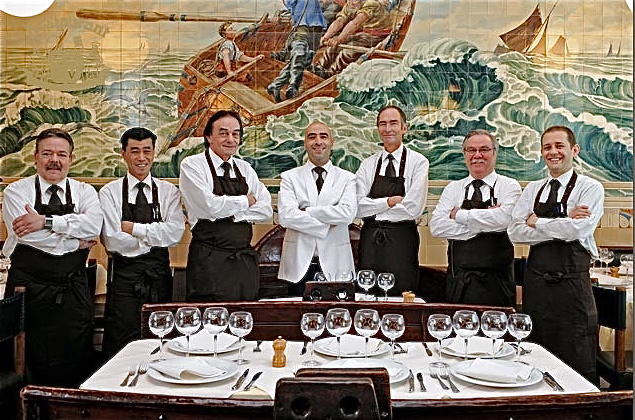 The desserts
will not astonish anyone for novelty but their
dependability is assured in plates of house-made ice
creams, crème caramel, and a selection of
crêpes. A glass of Sauternes is
suggested.
The desserts
will not astonish anyone for novelty but their
dependability is assured in plates of house-made ice
creams, crème caramel, and a selection of
crêpes. A glass of Sauternes is
suggested.If you go to Vincent for lunch, plan on a good walk for the afternoon. That's what my friends and I did, for another few hours, hardly tiring of the sights of the city, yet lured to taste just one more chocolate bonbon in that cute spot over there, maybe that shop's frites, or a shot of "half-and-half"--a glass of spumante and white wine, the specialty of Le Cirio, opened in 1886--and maybe if we just shared a single waffle. . . . We arrived sated and weary back at our hotel, the modern and very well run Dominican (below), right behind the Theater Monnaie
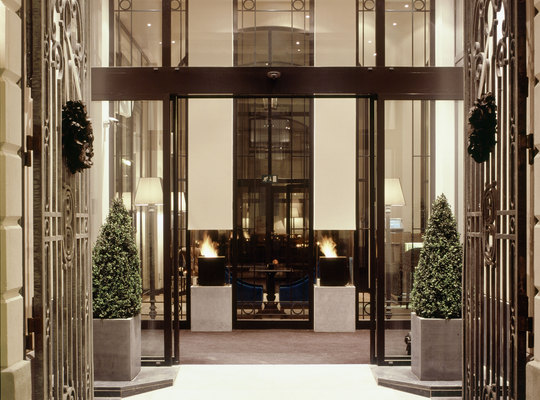 and and conveniently
located near the Grand Place and all the sights of
city center. Off the lobby, it has a Grand Lounge
restaurant where we enjoyed a generous breakfast
buffet. The rooms are spacious, the bathrooms
very well equipped, and everywhere are amenities of
media and Wi-Fi. Our friends stayed right
around the corner at the newly refurbished Sandton
Hotel Brussels Centre, with 70 rooms, which,
aside from interior construction noise, they found
to be a good hotel with the promise of being a very
fine one. Its underground parking lot is a boon.
and and conveniently
located near the Grand Place and all the sights of
city center. Off the lobby, it has a Grand Lounge
restaurant where we enjoyed a generous breakfast
buffet. The rooms are spacious, the bathrooms
very well equipped, and everywhere are amenities of
media and Wi-Fi. Our friends stayed right
around the corner at the newly refurbished Sandton
Hotel Brussels Centre, with 70 rooms, which,
aside from interior construction noise, they found
to be a good hotel with the promise of being a very
fine one. Its underground parking lot is a boon.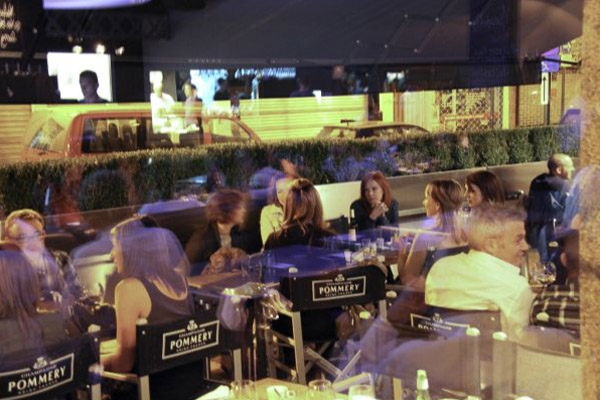 That
night I had occasion to return to an old favorite in
town, Royal
Brasserie Brussels (left), which years ago was a
high-end, handsome seafood restaurant much
frequented by a business crowd. A couple of years
back, the restaurant was bought and changed into a
far more casual all-purpose restaurant, where
seafood still forms a good part of the menu, while
the rest gets more continental in its scope. I
suppose it does meet the outer limits description of
a Belgian brasserie, though the in-your-face
promotion of Pommery Champagne makes it more a
Champagne bar and restaurant. To eat well
here, eat simply: platters of fresh shellfish will
do the trick--oysters, prawns, langoustines, whelks,
periwinkles--and the shrimp croquettes here are very
good. From there on, it depends on what you are in
the mood for, which can range from sushi to Iberian
ham, from rabbit rillettes to roast pigeon.
That
night I had occasion to return to an old favorite in
town, Royal
Brasserie Brussels (left), which years ago was a
high-end, handsome seafood restaurant much
frequented by a business crowd. A couple of years
back, the restaurant was bought and changed into a
far more casual all-purpose restaurant, where
seafood still forms a good part of the menu, while
the rest gets more continental in its scope. I
suppose it does meet the outer limits description of
a Belgian brasserie, though the in-your-face
promotion of Pommery Champagne makes it more a
Champagne bar and restaurant. To eat well
here, eat simply: platters of fresh shellfish will
do the trick--oysters, prawns, langoustines, whelks,
periwinkles--and the shrimp croquettes here are very
good. From there on, it depends on what you are in
the mood for, which can range from sushi to Iberian
ham, from rabbit rillettes to roast pigeon.It's a very affable place and the Italian-born owner keeps it that way by bouncing from table to table of regulars he knows well (often neglecting those he does not). If you do choose to eat outside, as is the case everywhere in Brussels, smoking is allowed, and anyone and everyone who smokes in the city will be out there, making the enjoyment of anyone else's meal difficult.
So you walk, slowly, through the city at night, its old buildings lighted, its trams and taxis humming by, and watch the waiters at the cafés piling up their chairs. Brussels becomes quite quiet, sleepy, and its charms even more apparent when you take the time to look for them.
❖❖❖
NEW
YORK CORNER
NEW
YORK'S MOST
NEW YORK RESTAURANTS
by John
Mariani
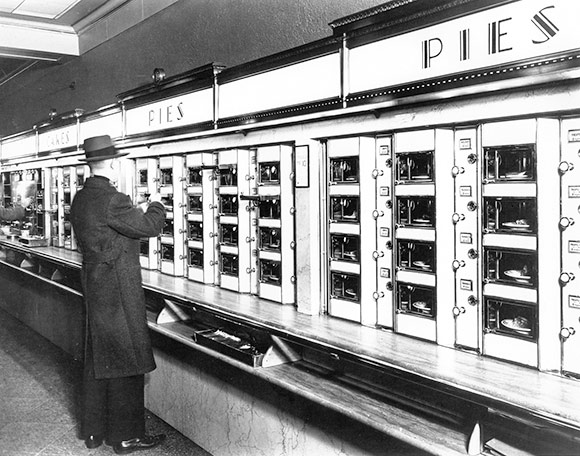
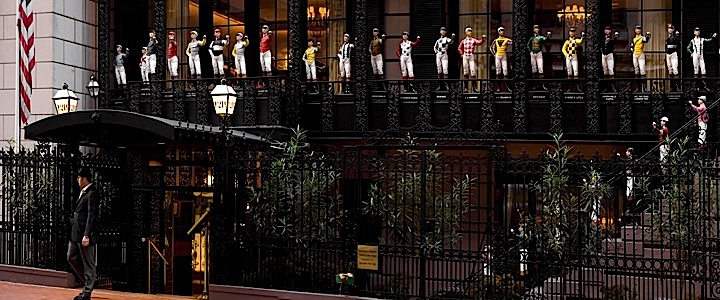
'21' Club
(1929)--Never an actual club but begun as a
speakeasy (complete with a secret wine cellar you
can still visit), `21' evolved into an exclusive
haunt of New York society. Today it is still a
raffish place to dine and the food has never been
better. The bar and lounge have been expanded
recently and the beautiful upstairs rooms are full
of Remington paintings and great graphic art. For
lunch have the famous `21' burger, at dinner the
Dover sole, beef tartare, and pommes soufflé.
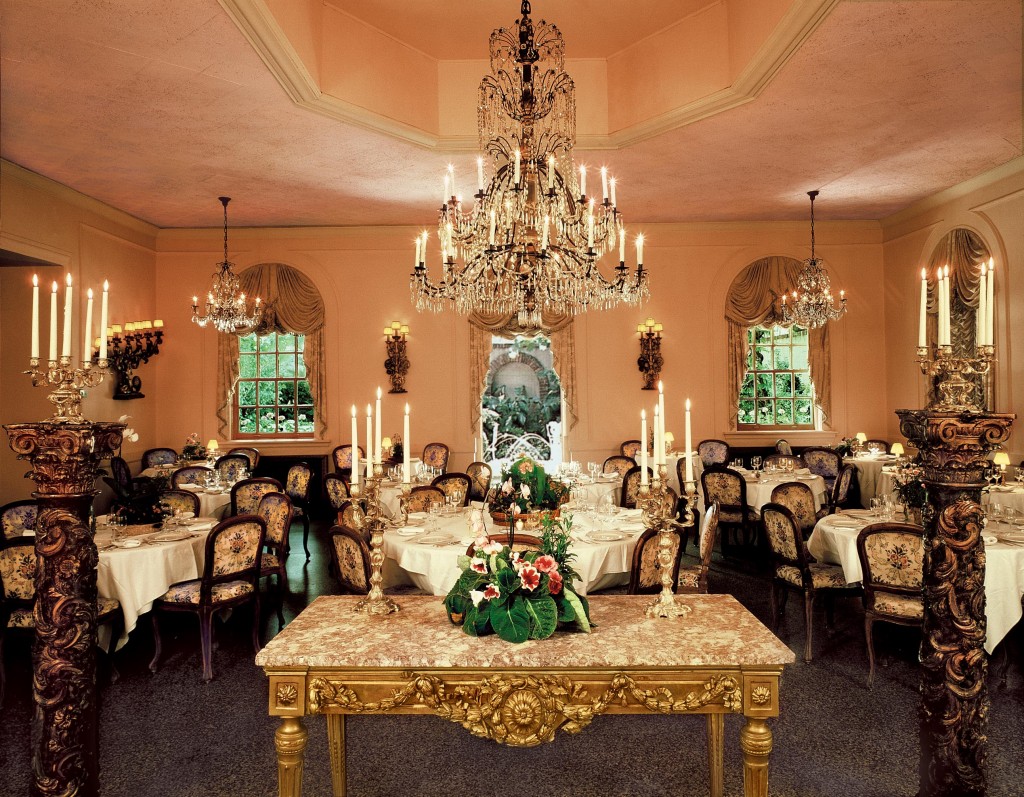
Barbetta
(1906)--The oldest continually operating Italian
restaurant in family hands, now under the
supervision of Laura Maioglio, the founder's
daughter, Barbetta is set in a turn-of-the-century
townhouse
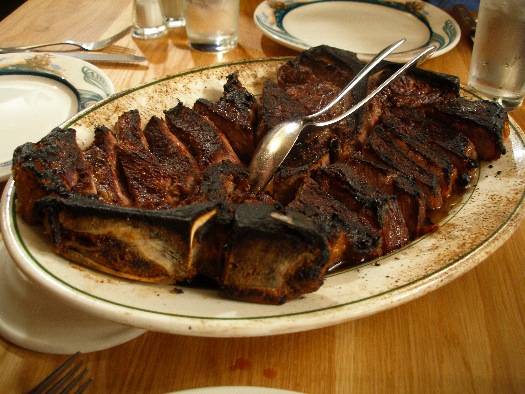 even weeks'
notice, Luger in Brooklyn stakes its claim on having
the best sliced porterhouse (right) in the
city (make that anywhere), sliced for two or three
or more. The place has never looked like
much--the quasi-Teutonic décor is not
particularly original, the wine list is weak, the
service brusque, but it is a pilgrimage well worth
taking if only for those steaks.
even weeks'
notice, Luger in Brooklyn stakes its claim on having
the best sliced porterhouse (right) in the
city (make that anywhere), sliced for two or three
or more. The place has never looked like
much--the quasi-Teutonic décor is not
particularly original, the wine list is weak, the
service brusque, but it is a pilgrimage well worth
taking if only for those steaks.
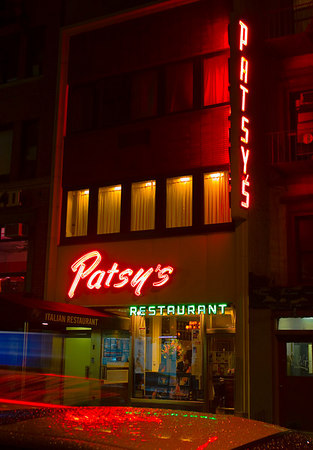
Patsy's
(1944)--Oddly enough, Patsy's is one of the few real
Neapolitan Italian-American restaurants left in
Manhattan, and its location in the Theater District
has made it a mecca for just about every star and
celebrity who's ever made a movie or appeared on the
stage. Their photos are arrayed on the walls, and
the Scognamillo family makes everyone feel like a
special guest. Just about everything on the menu has
been perfected, from the eggplant parmigiana and
gnocchi to the fried calamari and terrific
cheesecake.
Sardi's
(1927)--No one has ever raved about the continental
food at Sardi's but is a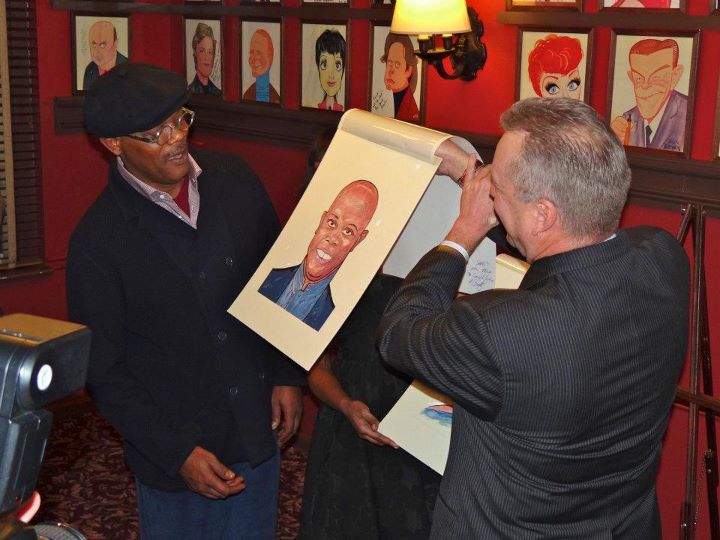 ritual for out-of-towners
to go pre-theater or attend a Broadway show then
repair here for dinner, perhaps with the cast
members of an opening night show who wait here for
the reviews to appear in the New York papers. The
celebrity cartoons (right) are as famous as anything
else about Sardi's. The shrimp scampi alla Sardi's
is still pretty darn delicious.
ritual for out-of-towners
to go pre-theater or attend a Broadway show then
repair here for dinner, perhaps with the cast
members of an opening night show who wait here for
the reviews to appear in the New York papers. The
celebrity cartoons (right) are as famous as anything
else about Sardi's. The shrimp scampi alla Sardi's
is still pretty darn delicious.
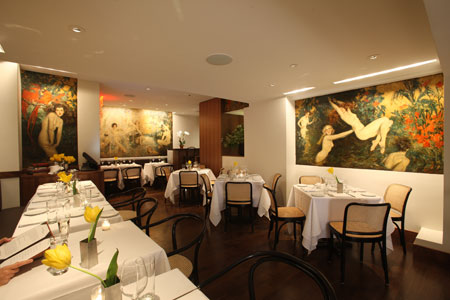
The Leopard at
des Artistes (1933)--Recently taken
over by the Sorrentino family (for my article on the
restaurant, click here), this venerable Upper West
Side series of rooms with naughty Howard Chandler
Christy murals (left)
has been a draw for decades of good, now Italian
food. Begin with a glass of prosecco then order the
eggplant and mozzarella timballo, move on to
spaghetti alla ghitarra and Sicilian rigatoni alla
Norma, and the wonderfully savory Italian meatloaf
here. Desserts are very good too.
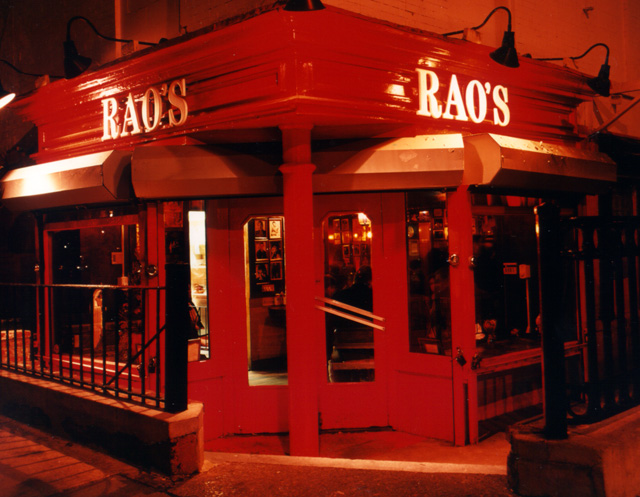 taken every night by regulars going
back 50 years, but if you do get invited by one of
those regulars (who sometimes release their table),
you'll find yourself in a time warp where nothing
ever changes, where the food comes in platters, and
Nicky the Vest still oversees the bar and never
picks up the phone.
taken every night by regulars going
back 50 years, but if you do get invited by one of
those regulars (who sometimes release their table),
you'll find yourself in a time warp where nothing
ever changes, where the food comes in platters, and
Nicky the Vest still oversees the bar and never
picks up the phone.

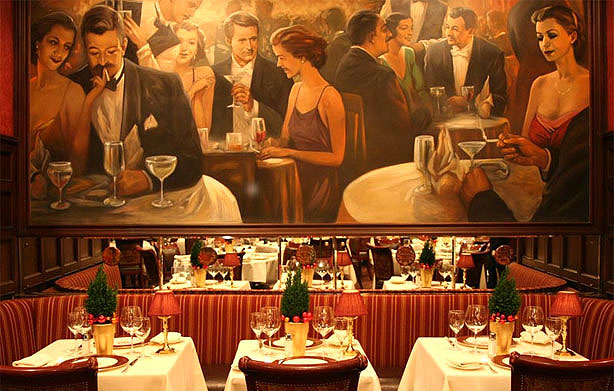 restaurant
opened in America, built on Parisian models, the
current Delmonico's (right) is an offshoot of the
first, much smaller original, and it has kept its
downtown swagger and Wall Street clientele happy
with excellent steaks and lobsters for 150 years. It
was at "Del's" that guests had a menu to choose
from; where the first Transatlantic cable was sent
and received; where women first dined alone; and the
place that set the standards for fine dining in the
Gilded Age.
restaurant
opened in America, built on Parisian models, the
current Delmonico's (right) is an offshoot of the
first, much smaller original, and it has kept its
downtown swagger and Wall Street clientele happy
with excellent steaks and lobsters for 150 years. It
was at "Del's" that guests had a menu to choose
from; where the first Transatlantic cable was sent
and received; where women first dined alone; and the
place that set the standards for fine dining in the
Gilded Age.
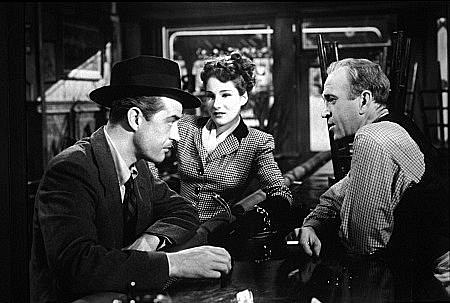 the movie "Lost Weekend"
(right)
were filmed here--Clarke's (as everyone calls it)
has much better food than McSorley's and a faithful
clientele you will have seen in the entertainment
pages. The hamburger is justifiably famous.
the movie "Lost Weekend"
(right)
were filmed here--Clarke's (as everyone calls it)
has much better food than McSorley's and a faithful
clientele you will have seen in the entertainment
pages. The hamburger is justifiably famous.
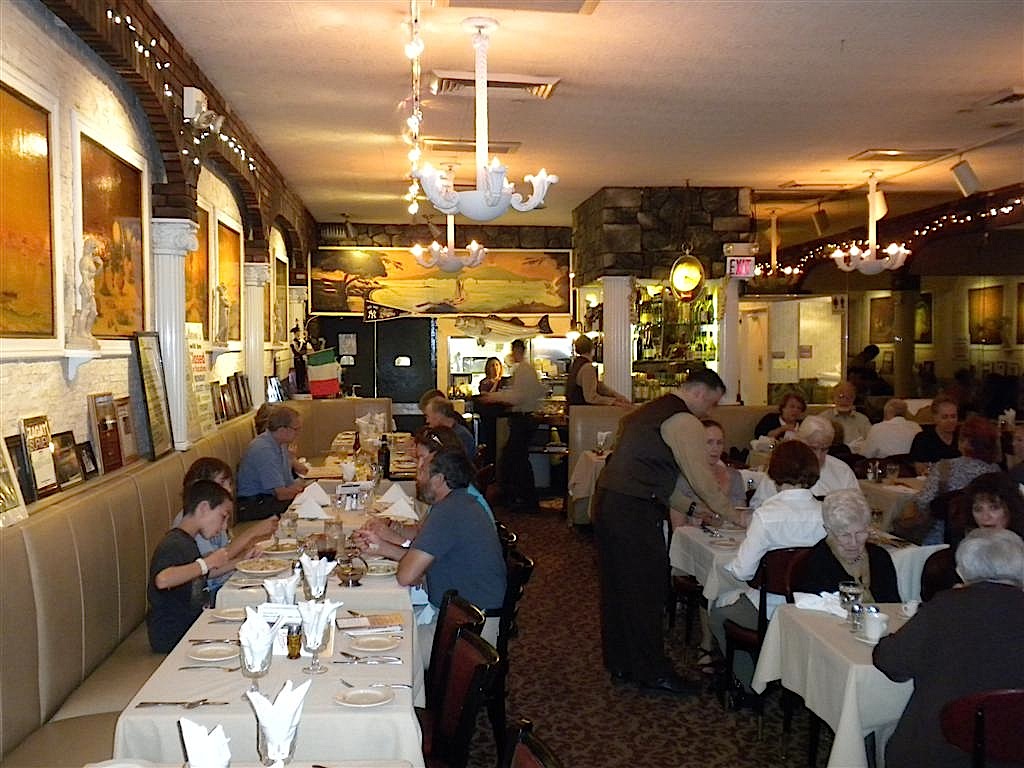
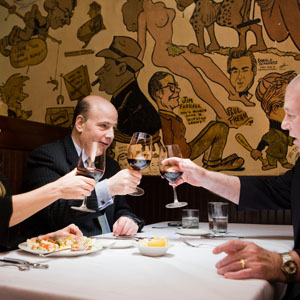 to the local newspapermen,
many of whom got their caricature on the walls here
(right).
The addition of a few Italian items made Palm the
crucible for the New Yawk-style steakhouse, with
many competitors over the years now long gone. The
menu never changes--tomato salad, big steamed
lobsters, massive veal chops, cheesecake. There are
plenty of Palm branches around the U.S. now, but I
guarantee that the original on Second Avenue still
gets the best beef possible and serves the finest
sirloin anywhere.
to the local newspapermen,
many of whom got their caricature on the walls here
(right).
The addition of a few Italian items made Palm the
crucible for the New Yawk-style steakhouse, with
many competitors over the years now long gone. The
menu never changes--tomato salad, big steamed
lobsters, massive veal chops, cheesecake. There are
plenty of Palm branches around the U.S. now, but I
guarantee that the original on Second Avenue still
gets the best beef possible and serves the finest
sirloin anywhere.
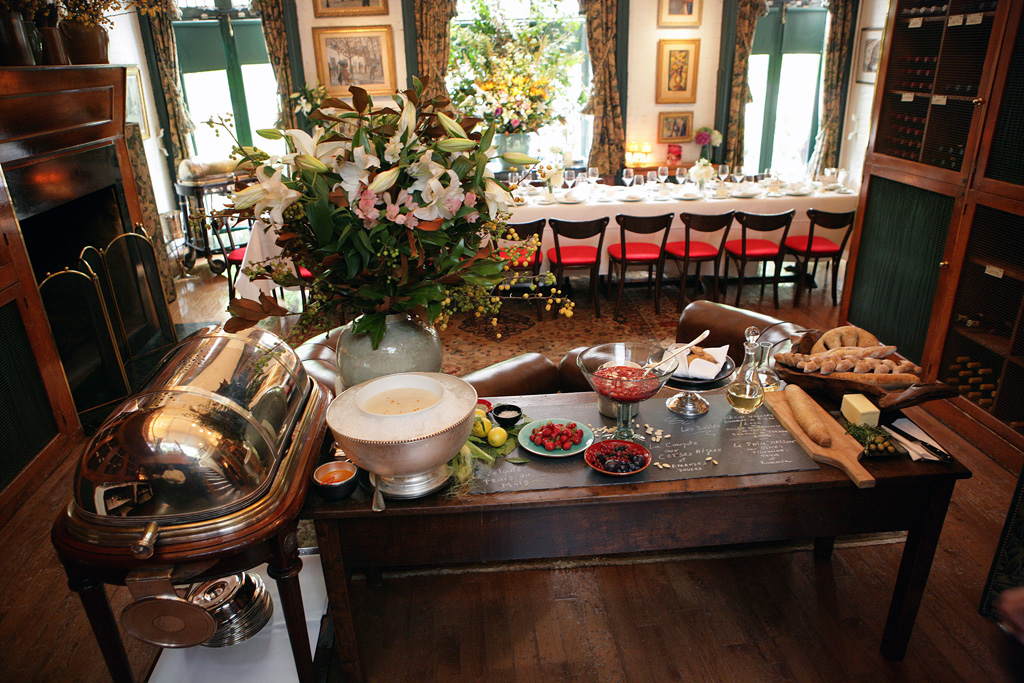
La Grenouille
(1952)--One of the few remaining old
line French grand dame restaurants, La Grenouille,
in all its effusive, flowery glory, is a bastion of
good taste and classic French cuisine. Once
very haughty indeed, La Grenouille (left) now
thrives on a more egalitarian approach to its guests
and does so without gouging on the menu.
Charles Masson, son of the founders, is a master of
gentility and hospitality.
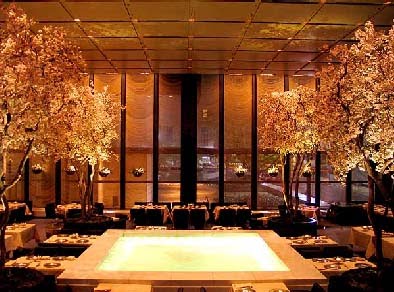 space like no other, The
Four Seasons is still a dazzling and unique
restaurant, with a babbling pool in its main dining
room (right)
and a Grill Room and bar whose tables are daily
occupied by the powerbrokers of New York each day.
It was a champion of New American Cuisine and
California wines, and managing partners Alex von
Bidder and Julian Niccolini run their fiefdom with
enormous savvy.
space like no other, The
Four Seasons is still a dazzling and unique
restaurant, with a babbling pool in its main dining
room (right)
and a Grill Room and bar whose tables are daily
occupied by the powerbrokers of New York each day.
It was a champion of New American Cuisine and
California wines, and managing partners Alex von
Bidder and Julian Niccolini run their fiefdom with
enormous savvy.
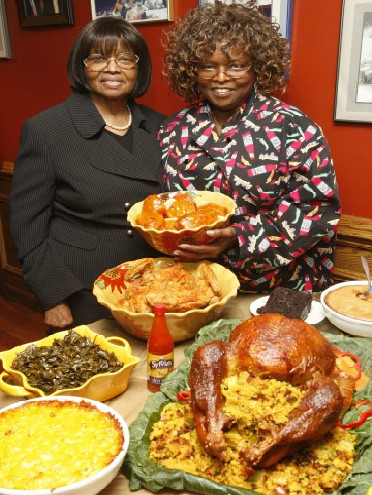
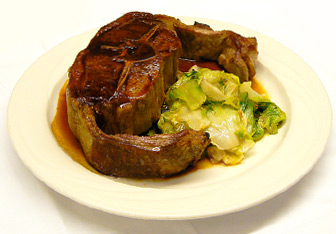 hanging its historic clay
pipes from the ceiling, Keen's is a very, very
historic place with memorabilia of museum
quality. You step back in time here, order the
mutton chop (right),
and feel you are part of the Gilded Age.
hanging its historic clay
pipes from the ceiling, Keen's is a very, very
historic place with memorabilia of museum
quality. You step back in time here, order the
mutton chop (right),
and feel you are part of the Gilded Age.
The Hotel Carlyle Restaurant (1930)--The
word soigné may well have been coined to
describe the dining room (left) at The Carlyle Hotel, which
also has the Bemelmans Bar where Woody Allen plays
in a New Orleans jazz band each week, and the Cafe
Carlyle that draws the top crooners of the day.
Swank but not swanky, the dining room here is
beautiful, well set with the finest amenities, and
serves a good American meal.
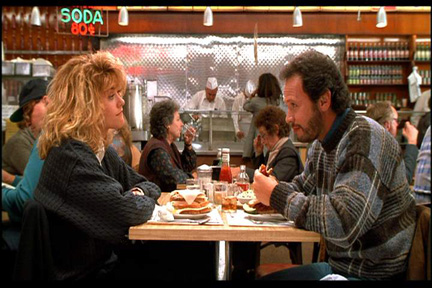 and tongue by hand, the
sandwiches are enormous, it's still got the sign
from World War II reading "Send a Salami to Your Boy
in the Army," the famous faked orgasm scene in "When
Harry Met Sally" (right)
was shot here, and the Jewish shtick between the
staff and the customers could fill a Henny Youngman
routine.
and tongue by hand, the
sandwiches are enormous, it's still got the sign
from World War II reading "Send a Salami to Your Boy
in the Army," the famous faked orgasm scene in "When
Harry Met Sally" (right)
was shot here, and the Jewish shtick between the
staff and the customers could fill a Henny Youngman
routine.
❖❖❖
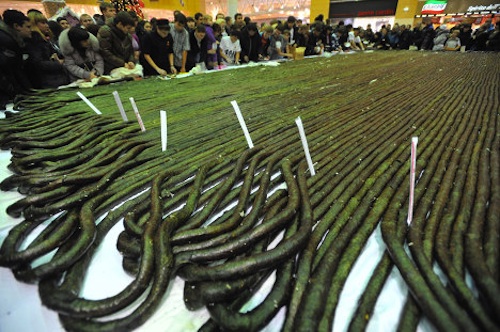
Sixty
chefs in Yekaterinburg, Russia constructed a sushi
roll 2.521 meters, 74 centimeters long (over a mile and a
half), beating the record of 2.033
meters set by the Council of Japanese Postal Workers’
Union in 2007. The Russians used
and aprons are . . . People!!!
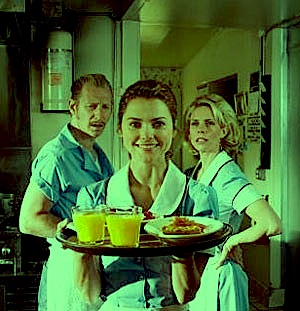
"The biscuits are one of the most moreishly flirty things a bread can aspire to. I had mine stuffed with bacon, egg and cheese. . . . If you like the dish, you can buy the ingredients in a shop at the front, like Star Wars memorabilia. They have taken it one step further; the leather from your burgers is made into handbags and belts. There are stripey jerseys and aprons, possible made out of old waitresses."--A.A. Gill, "Table Talk: Marlow & Sons; Diner, Brooklyn, NY," London Times Magazine.
Any of John Mariani's
books below may be ordered from amazon.com.
 |
My latest book, which just won the prize for best book from International Gourmand, written with Jim Heimann and Steven Heller, Menu Design in America, 1850-1985 (Taschen Books), has just appeared, with nearly 1,000 beautiful, historic, hilarious, sometimes shocking menus dating back to before the Civil War and going through the Gilded Age, the Jazz Age, the Depression, the nightclub era of the 1930s and 1940s, the Space Age era, and the age when menus were a form of advertising in innovative explosions of color and modern design. The book is a chronicle of changing tastes and mores and says as much about America as about its food and drink.
“Luxuriating vicariously in the pleasures of this book. . . you can’t help but become hungry. . .for the food of course, but also for something more: the bygone days of our country’s splendidly rich and complex past. Epicureans of both good food and artful design will do well to make it their coffee table’s main course.”—Chip Kidd, Wall Street Journal.
“[The menus] reflect the amazing craftsmanship that many restaurants applied to their bills of fare, and suggest that today’s restaurateurs could learn a lot from their predecessors.”—Rebecca Marx, The Village Voice. |
"Eating Italian will never be the same after reading John Mariani's entertaining and savory gastronomical history of the cuisine of Italy and how it won over appetites worldwide. . . . This book is such a tasteful narrative that it will literally make you hungry for Italian food and arouse your appetite for gastronomical history."--Don Oldenburg, USA Today. "Italian
restaurants--some good, some glitzy--far
outnumber their French rivals. Many of
these establishments are zestfully described
in How Italian Food Conquered the World, an
entertaining and fact-filled chronicle by
food-and-wine correspondent John F.
Mariani."--Aram Bakshian Jr., Wall Street
Journal.
"Equal parts
history, sociology, gastronomy, and just
plain fun, How Italian Food Conquered the
World tells the captivating and delicious
story of the (let's face it) everybody's
favorite cuisine with clarity, verve and
more than one surprise."--Colman Andrews,
editorial director of The Daily
Meal.com. "A fantastic and fascinating
read, covering everything from the influence
of Venice's spice trade to the impact of
Italian immigrants in America and the
evolution of alta cucina. This book will
serve as a terrific resource to anyone
interested in the real story of Italian
food."--Mary Ann Esposito, host of PBS-TV's
Ciao
Italia. "John Mariani has written the
definitive history of how Italians won their
way into our hearts, minds, and
stomachs. It's a story of pleasure over
pomp and taste over technique."--Danny Meyer,
owner of NYC restaurants Union Square Cafe,
Gotham Bar & Grill, The Modern, and
Maialino.
|
 |
 |
 |
 |
 |
 |
 |
 |
 Everett Potter's Travel Report:
Everett Potter's Travel Report: 
 Eating Las Vegas
is the new on-line site for Virtual Gourmet
contributor John A. Curtas., who since 1995
has been commenting on the Las Vegas food
scene and reviewing restaurants for Nevada
Public Radio. He is also the
restaurant critic for KLAS TV, Channel 8 in
Las Vegas, and his past reviews can be
accessed at KNPR.org.
Click on the logo below to go directly to
his site.
Eating Las Vegas
is the new on-line site for Virtual Gourmet
contributor John A. Curtas., who since 1995
has been commenting on the Las Vegas food
scene and reviewing restaurants for Nevada
Public Radio. He is also the
restaurant critic for KLAS TV, Channel 8 in
Las Vegas, and his past reviews can be
accessed at KNPR.org.
Click on the logo below to go directly to
his site.

Tennis Resorts Online: A Critical Guide to the World's Best Tennis Resorts and Tennis Camps, published by ROGER COX, who has spent more than two decades writing about tennis travel, including a 17-year stretch for Tennis magazine. He has also written for Arthur Frommer's Budget Travel, New York Magazine, Travel & Leisure, Esquire, Money, USTA Magazine, Men's Journal, and The Robb Report. He has authored two books-The World's Best Tennis Vacations (Stephen Greene Press/Viking Penguin, 1990) and The Best Places to Stay in the Rockies (Houghton Mifflin, 1992 & 1994), and the Melbourne (Australia) chapter to the Wall Street Journal Business Guide to Cities of the Pacific Rim (Fodor's Travel Guides, 1991).


The Family Travel Forum - A
community for those who "Have Kids, Still Travel" and
want to make family vacations more fun, less work and
better value. FTF's travel and parenting features,
including reviews of tropical and ski resorts, reunion
destinations, attractions, holiday weekends, family
festivals, cruises, and all kinds of vacation ideas
should be the first port of call for family vacation
planners. http://www.familytravelforum.com/index.html
ALL YOU NEED BEFORE YOU GO


MARIANI'S VIRTUAL GOURMET
NEWSLETTER is published weekly. Editor/Publisher: John
Mariani.
Contributing Writers: Christopher Mariani, Robert Mariani,
John A. Curtas, Edward Brivio, Mort Hochstein,
Suzanne Wright, and Brian Freedman. Contributing
Photographers: Galina Stepanoff-Dargery,
Bobby Pirillo. Technical Advisor: Gerry McLoughlin.
© copyright John Mariani 2012
